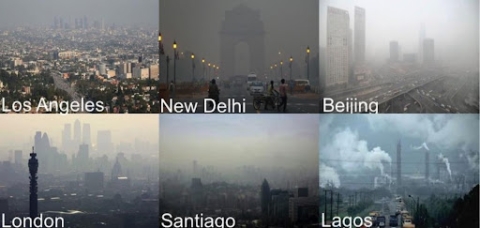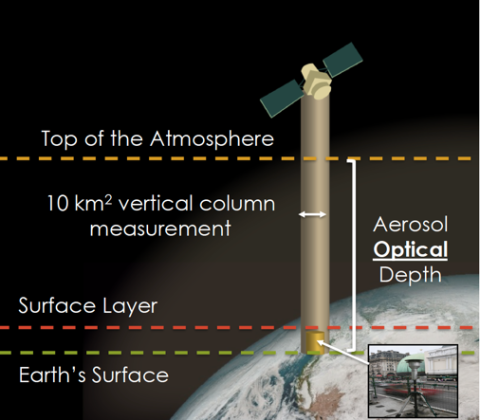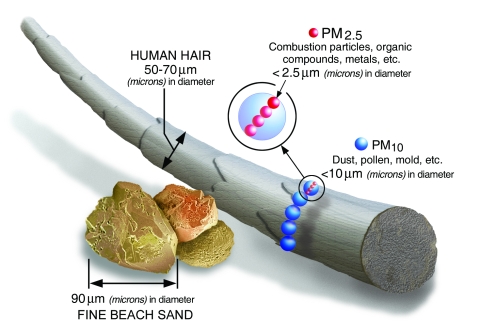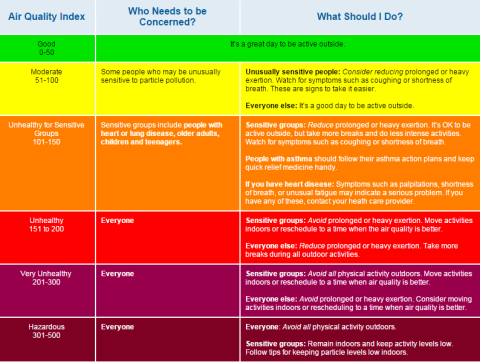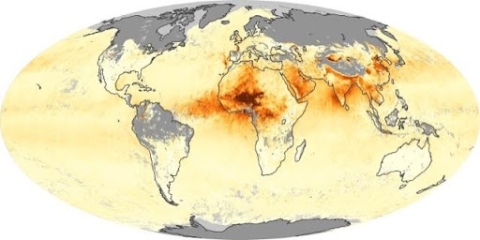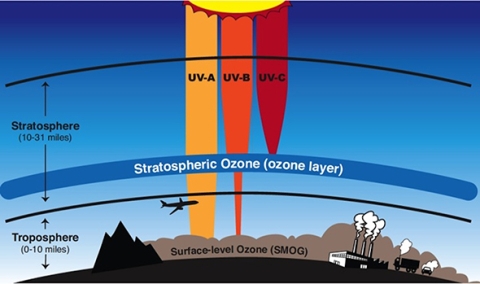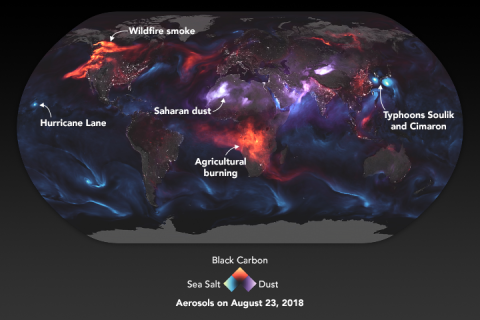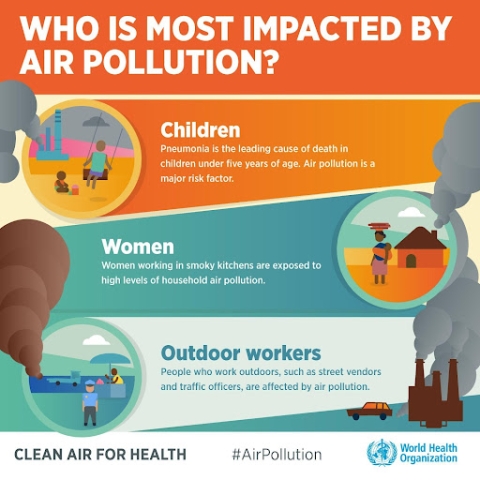According to the World Health Organization (WHO), outdoor air pollution contributes to millions of deaths every year, making it one of the biggest global health risks. In addition, 9 out of 10 people worldwide breathe air that exceeds WHO pollution guidelines.
The causes of air pollution vary from human activities (such as coal-fired power plants) to natural events (like wildfires and dust storms). While the U.S. is fortunate to have provisions for numerous ground-based measurements for assessing air quality and the concentrations of different types of atmospheric pollution, this is not the case in other countries (or even in some regions of the U.S.). Since air pollution is a global hazard, a combination of airborne, ground, and satellite-based tools is necessary to better understand the movement of pollutants and the impact of events leading to poor air quality.
The Benefits of Satellite Sensor Data
Sensors aboard orbiting satellites provide global coverage as often as twice a day, enabling the assessment of air quality over large areas of Earth. Some of these data are available as rapidly as three hours after an observation, which enables scientists, public health professionals, air quality managers, and decision makers to respond rapidly to ongoing events and make critical decisions regarding the risks for health conditions or diseases that can be exacerbated by poor air quality. For more information about remotely sensed data and techniques, please see the What is Remote Sensing? Backgrounder.
While satellites can provide a global view, it’s important to note that satellite-borne sensors are measuring the vertical column of atmosphere extending from the satellite to the surface and not surface level concentrations of pollutants (these data are collected by sensors installed in ground-based stations or carried aboard aircraft). As such, there may be some discrepancies between measurements acquired by sensors aboard satellites and by instruments closer to the surface.
Satellite-acquired data have many health and air quality applications, including:
- Monitoring the movement of wildfire smoke and dust plumes
- Tracking the path of ash from volcanic eruptions
- Identifying concentrations of nitrogen dioxide (NO2), sulfur dioxide (SO2), and other pollutants near cities, suburbs, and major transportation systems
- Understanding how concentrations of these pollutants are changing over time
To learn more about these applications, see the Getting Started Resource produced by NASA’s Health and Air Quality Applied Sciences Team (HAQAST). Additional articles explaining how how NASA data are being used to investigate the health impacts of air pollution include:
- New Insights in Air Quality Monitoring Using Satellite Data (The Magazine for Environmental Managers, September 2021)
- NASA Satellites Help Scientists Determine the Global Burden of Asthma (NASA Applied Sciences Program, October 24, 2019)
- Integration of Airborne Dust Prediction Systems and Vegetation Phenology to Track Pollen for Asthma Alerts in Public Health Decision Support Systems (NASA Applied Sciences Program, Project Report)
- NASA Satellite Helps Collect 15 Years of Southern California Air Pollution data; Results Show Air Pollution Controls Working (California Air Resources Board, June 5, 2018; Release Number 18-33)
- Aerosols
-
A human hair is much larger than PM10 and PM2.5 aerosols. As a result, aerosols can remain suspended while they travel great distances. Their small size also enables them easily to be inhaled into the lungs. Credit: U.S. EPA. Aerosols are minute solid particles or liquid droplets that are suspended in the atmosphere. A single aerosol particle is hard to detect by the human eye since most aerosols are 10 microns or smaller in size. A human hair, in comparison, has a diameter of between 17 and 181 microns. Aerosols are a form of particulate matter (PM); PM is classified based on the average size of the particles comprising it in microns (e.g., PM1.0, PM2.5, and PM10). PM10 is a common designation and refers to aerosols with a diameter of 10 microns or smaller, such as dust or pollen. Air-quality reports frequently identify a PM10 subgroup called PM2.5, which includes PM with diameters of 2.5 microns or smaller, such as particles formed through combustion and organic compounds.
Aerosols, or the gases that lead to their formation, come from many sources. They can come from exhaust from vehicle tailpipes and from desert sands, from sea spray and fires, volcanic eruptions and factories. Even forests, soils, or communities of ocean plankton can be aerosol sources. In addition, many aerosols are “secondary pollutants,” meaning they are formed in the atmosphere through chemical reactions of other pollutants and chemicals or are formed when individual molecules start to clump together. When there are high concentrations of aerosols, we say that the air is polluted. Because of their minute size, aerosols easily are transported long distances by global air currents. To learn more about aerosols, see the Earth Observing article Aerosols: Tiny Particles, Big Impact.
The Air Quality Index is a tool developed by the EPA to communicate, report, and forecast air quality information. Click on image for larger view. Credit: EPA. People and animals can easily inhale aerosols. While larger particles (such as sea salt) tend to fall rapidly from the air, smaller particles (such as PM10 and PM2.5) can remain suspended and be transported long distances. More importantly, their small size enables them to be inhaled easily and lodge in the lungs and bloodstream, fueling a variety of cardiovascular and respiratory diseases. For a given aerosol type, those in the PM2.5 size group are more harmful than larger size groups. Air quality reports often represent aerosol concentrations as the number of particles by mass per unit volume of air (usually in units of micrograms per cubic meter).
Global average monthly AOD for March 2022. Pale yellow areas (such as over Australia) indicate regions with low aerosol concentrations and high visibility; reddish brown areas (such as over Africa) indicate regions with high concentrations of aerosols and low visibility. Gray indicates areas with no data. Credit: NASA Earth Observatory. Aerosols scatter and absorb incoming sunlight, which reduces visibility. The degree of absorption and scattering depends upon the particle’s composition. The measurement of the level to which aerosols prevent light from traveling through the atmosphere is called Aerosol Optical Depth (AOD). AOD is a measure of the quantity of light that small particles remove by absorption and scattering within a column.
From an observer on the ground, an AOD of less than 0.1 is characteristic of a clear sky and maximum visibility. As AOD increases to 0.5, 1.0, and greater than 3.0, aerosols become so dense that the Sun is obscured. For more information on this process, check out the NASA Earth Observatory article Aerosols and Incoming Sunlight.
AOD Use Cases on YouTube:
- Learn how NASA is working with the National Park Service to use AOD data from NASA satellites to determine visibility across the public lands it manages
- See how NASA is working with Maricopa County in Arizona to monitor air quality in the greater Phoenix metropolitan area
- Trace Gases
-
Nitrogen, oxygen, and argon make up more than 99% of Earth’s atmosphere. Other gases, such as nitrogen dioxide, sulfur dioxide, carbon monoxide, ozone, carbon dioxide, water vapor, methane, and ammonia, are considered trace gases. Although relatively unimportant in terms of their absolute volume, trace gases have significant impacts on Earth’s weather and climate. Trace gases also are constituents of harmful pollutants. The following sections describe some of the key trace gas pollutants in more detail.
Ozone
Ozone is found throughout Earth’s atmosphere, although it is concentrated about 15 miles above Earth’s surface in the Ozone Layer. This layer filters harmful UV light (UV-B and UV-C) and protects life on Earth. Surface-level Ozone forms from combustion and is often associated with smog. Credit: NASA Aura. Ozone (O3) is a trace gas that can be either beneficial or harmful depending on where it is found in the atmosphere. Beneficial O3 is found naturally in trace amounts in the upper atmosphere (the stratosphere), where it protects life on Earth from the Sun’s ultraviolet (UV) radiation. Harmful O3 is found in the troposphere or closer to ground level, where it serves as a potent greenhouse gas and can aggravate existing health problems in humans, especially those with respiratory conditions. O3 is not emitted directly into the atmosphere, but instead forms from the chemical reaction between nitrogen oxides and volatile organic compounds that are emitted from cars powered by internal combustion engines, power plants, and other industrial facilities. Reactions to create O3 take place in the presence of sunlight. Because of the need for sunlight, unhealthy levels of O3 are most often reached on very sunny days and in urban environments.
Nitrogen Dioxide
Nitrogen Dioxide (NO2) is a pollutant, the primary sources being the burning of fossil fuels and exhaust from industry and automobiles powered by internal combustion engines. Once in the air, it can aggravate respiratory conditions, especially asthma. Long-term exposure can lead to the development of asthma and can increase susceptibility to respiratory infections. NO2 reacts with other chemicals in the atmosphere to form particulate matter and ozone. This can lead to a chemical haze and even acid rain. NO2 also contributes to nitrogen pollution in lakes, streams, and coastal waters. NASA’s Air Quality website provides more information about NO2 as well as trend maps and pre-made images of NO2 over cities and near power plants.
For more information, please see the NASA ARSET YouTube video How NASA Measures Nitrogen Dioxide (NO2), Part 1/2.
Sulfur Dioxide
The primary source of sulfur dioxide (SO2) is the burning of fossil fuels by power plants and industry. Volcanic eruptions also contribute to atmospheric SO2, and these emissions can be tracked using orbiting sensors. As with NO2, SO2 can aggravate respiratory conditions in humans, especially those with asthma. In areas with high levels of SO2, sulfur oxides can lower visibility and create acid rain. NASA’s Global Sulfur Dioxide Monitoring Home Page provides a global overview of SO2 sources and concentrations.
Carbon Monoxide
Carbon monoxide (CO) is a harmful pollutant formed by the incomplete combustion of fuels. Primary sources of CO are through the combustion of fossil fuels or biomass burning. Outdoor levels of CO are rarely high enough to cause issues; when they do reach dangerous levels, however, they can be of concern to people with certain types of heart disease.
- Measuring the Transport of Pollutants
-
A NASA model called the Goddard Earth Observing System Forward Processing (GEOS FP) offers an expansive view of the mishmash of particles dancing and swirling through the atmosphere on August 23, 2018. Click on image for larger view. Credit: NASA Earth Observatory image by Joshua Stevens, using GEOS data from the Global Modeling and Assimilation Office at NASA's Goddard Space Flight Center. For years, scientists have observed belts of air pollution traveling on wind currents, following weather patterns, and crossing the ocean and continents. Drifting pollution has the potential to affect people worldwide. The following sections describe some common measurements used to track pollutants: the Aerosol Index, the Dust Score, and Surface Reflectance assessments.
Aerosol Index
Aerosol Index (AI) is a measurement related to AOD and indicates the presence of increased concentrations of aerosols in the atmosphere. Satellite-derived AI products are useful for identifying and tracking the long-range transport of volcanic ash from eruptions, smoke from wildfires or biomass burning, dust from desert dust storms, and the movement of clouds and areas of snow and ice. The lower the AI value, the clearer the sky.
Dust Score
Very large dust storms lasting hours or days can easily be observed and tracked using satellite imagery. The most common source of dust globally is the Sahara Desert. Giant dust storms periodically sweep off the coast of West Africa and can be transported as far as Florida and the Caribbean. The Earthdata YouTube video A Clearer View of the Haze—Using NASA GES DISC Data Tools to Examine the June 2020 Sahara Dust Event describes how dust from the West Coast of Africa was tracked to the Caribbean using tools available through NASA’s Goddard Earth Sciences Data and Information Services Center (GES DISC).
The amount of dust transported by these storms can be quantified with the Dust Score, which is calculated from data acquired by the Atmospheric Infrared Sounder (AIRS) instrument aboard NASA’s Aqua satellite. The AIRS Dust Score indicates the level of atmospheric aerosols in Earth’s atmosphere over the ocean. Dust is probable when the score is above 380, and higher scores indicate more certainty that dust is present. The AIRS Dust Score can be visualized using NASA Worldview.
Surface Reflectance
Surface reflectance is the amount of light reflected by Earth’s surface. Light colored surfaces, such as ground covered with fresh white snow, reflect a high amount of light striking them and appear bright in satellite imagery. Dark or rough surfaces, such as dense forests or dark volcanic rock, reflect far less light and appear darker in imagery. Surface reflectance data are useful when comparing multiple images for the same region to detect and characterize changes to Earth’s surface. As pollutants or aerosols like dust spread over an area, they can change the surface reflectance detected by sensors aboard orbiting satellites. More detailed information is available through the NASA Land, Atmosphere Near real-time Capability for EO (LANCE) Air Quality page.
- Air Quality and Environmental Justice
-
Click on image for larger view. Credit: WHO. Air quality-related deaths and diseases that are exacerbated by air pollution are preventable, but prevention requires a knowledge of where vulnerable populations exist and what interventions are needed in these communities. Poor air quality tends to be elevated in low to middle-income countries, where 98% of urban centers with populations greater than 100,000 do not meet WHO guidelines.
Integrating socioeconomic data with air quality data can provide a more accurate analysis of populations facing greater exposure and vulnerability from pollutants. A number of socioeconomic factors need to be considered when analyzing air quality, including:
- Population
- Poverty
- Unemployment
- Academic attainment
- Housing burden
- Social vulnerability
NASA’s Socioeconomic Data and Applications Center (SEDAC) is the home for socioeconomic data in NASA’s Earth Observing System Data and Information System (EOSDIS) collection. Hosted at Columbia University’s Center for International Earth Science Information Network (CIESIN), SEDAC synthesizes Earth science and socioeconomic data and information in ways useful to a wide range of decision makers and other applied users and serves as an “Information Gateway” between the socioeconomic and Earth science data and information domains.
SEDAC’s Air Quality Data for Health-Related Applications data collection provides air quality data for health-related research and applications. This collection consists of the Daily and Annual PM2.5 Concentrations for the Contiguous United States, 1-km Grids, v1 (2000 – 2016) and Daily 8-Hour Maximum and Annual O3 Concentrations for the Contiguous United States, 1-km Grids, v1 (2000 – 2016) datasets. A similar NO2 dataset is in development.
Combining regional or community-level socioeconomic data (such as life expectancy, prevalence of asthma, or prevalence of health insurance coverage) with Earth science data (such as NO2 and SO2 concentrations) provides a way of examining environmental justice aspects of air quality and exploring how certain communities are impacted to a greater degree by pollution. For more information about how NASA is applying Earth science data to environmental justice, please see the Environmental Justice at NASA Backgrounder. The following open access articles provide additional information about research using Earth science data to explore environmental justice:
- Estimating Intra-Urban Inequities in PM2.5-Attributable Health Impacts: A Case Study for Washington, D.C. (doi:10.1029/2021GH000431)
- Estimating Daily PM2.5 Concentrations in New York City at the Neighborhood-Scale: Implications for Integrating Non-Regulatory Measurements (doi:10.1016/j.scitotenv.2019.134094)
- Air Quality and Environmental Injustice in India: Connecting Particulate Pollution to Social Disadvantages (doi:10.3390/ijerph18010304)
- Developing an Adaptive Pathway to Mitigate Air Pollution Risk for Vulnerable Groups in South Korea (doi:10.3390/su12051790)
To get started using health and air quality data in NASA's Earth Observing System Data and Information System (EOSDIS) collection and for links to tools and resources for analyzing and working with these data, please see the Health and Air Quality Data Pathfinder.
